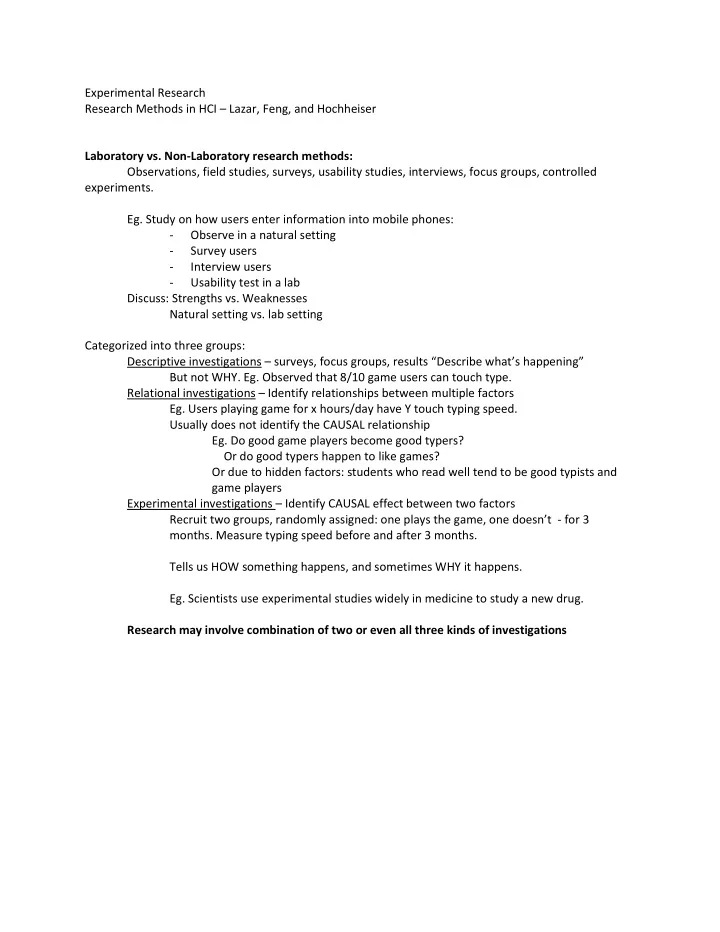

Experimental Research Research Methods in HCI – Lazar, Feng, and Hochheiser Laboratory vs. Non-Laboratory research methods: Observations, field studies, surveys, usability studies, interviews, focus groups, controlled experiments. Eg. Study on how users enter information into mobile phones: - Observe in a natural setting - Survey users - Interview users - Usability test in a lab Discuss: Strengths vs. Weaknesses Natural setting vs. lab setting Categorized into three groups: Descriptive investigations – surveys, focus groups, r esults “Describe what’s happening” But not WHY. Eg. Observed that 8/10 game users can touch type. Relational investigations – Identify relationships between multiple factors Eg. Users playing game for x hours/day have Y touch typing speed. Usually does not identify the CAUSAL relationship Eg. Do good game players become good typers? Or do good typers happen to like games? Or due to hidden factors: students who read well tend to be good typists and game players Experimental investigations – Identify CAUSAL effect between two factors Recruit two groups, randomly assigned: one plays the game, one doesn’t - for 3 months. Measure typing speed before and after 3 months. Tells us HOW something happens, and sometimes WHY it happens. Eg. Scientists use experimental studies widely in medicine to study a new drug. Research may involve combination of two or even all three kinds of investigations
2.2 Research Hypothesis Experiments start with a Research Hypothesis: A precise problem statement that can be directly tested through an empirical investigation. Versus: a Theory is usually a larger scope. Eg. Fitts’ Law: A general theory applied to various kinds of pointing devices In movement tasks, the movement time increases as the movement distance increases and the size of the target decreases. The movement time has a log linear relationship between the movement distance and the width of the target. - Impossible to verify with a few experiments - Hundreds of studies have been conducted Null hypothesis and alternative hypothesis - Null Hypothesis: No difference between experimental treatments - Alternative: Mutually exclusive hypothesis Goal: Find statistical evidence to nullify the null hypothesis. Some experiments have several pairs of null/alternative hypotheses Eg. – note the mutually exclusive: H0 – There is no difference between the pull-down menu and the pop-up menu in the time spent locating pages. H1 – There is a difference between the pull-down menu and the pop-up menu in the time spent locating pages. H0 – There is no difference in user satisfaction rating between the pull-down menu and the pop- up menu. H1 – There is a difference in user satisfaction rating between the pull-down menu and the pop- up menu. Avoid testing too many hypotheses in a single experiment! A good hypothesis: - Presented in precise, lucid language; - Is focused on a problem that is testable in one experiment - Clearly states the control groups or the conditions of the experiment Observational studies can lead to good hypothesis. In the early stage, conducting descriptive investigations and observations helps define the research problem.
Dependent and Independent Variables Hypothesis states dependent and independent variables. Independent: - The factors that the researcher aims to study, or the cause in the change of dependent variable. “The variable is independent of the participant’s behavior” Dependent: The outcome or effect the researcher is interested in. “dependent” on the participants behavior or changes in the independent variable. Rule of thumb: Independent variables are treatments or conditions that are controlled by the researcher, dependent variables are the outcomes the researcher needs to measure. Eg. There is no difference between the pull-down menu and the pop-up menu in the time spent locating pages. Independent variable is the type of the menu. Dependent variable is the time spent locating web pages. Notice that the dependent variable can have other factors: previous experience, reading speed, physical capabilities, etc. In HCI: Independent variables related to technologies, users, and the context in which the technology is used, eg: - Different types of technology or device,s such as typing versus speech-based diction, mouse versus joystick, touchpad, and other pointing devices; - Different types of design, such as pull-down vs. pop-up menu, font sizes, contrast, colors, website architecture. Users: age, gender, experience, profession, education, culture, motivation , mood, disabilities. Physical factors: noise, lighting, temperature, vibration, status of standing, seated, walking, jogging Social Factors: number of people surrounding the user and relationship Dependent variables: Five groups Efficiency, accuracy, subjective satisfaction, easy of learning and retention rate, physical or cognitive demand Efficiency – how fast (eg. Time to complete) Accuracy – eg . error rate – Note likely relationship between efficiency and accuracy, MEASURE BOTH Subjective Satisfaction – User ’ s perceived satisfaction Ease of learning – Physical or cognitive demand.
Recommend
More recommend